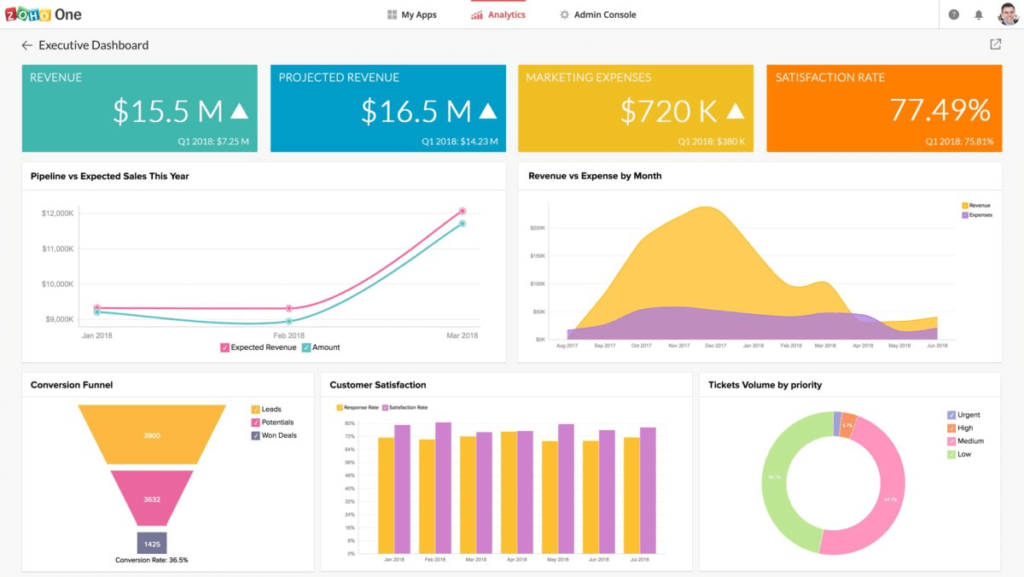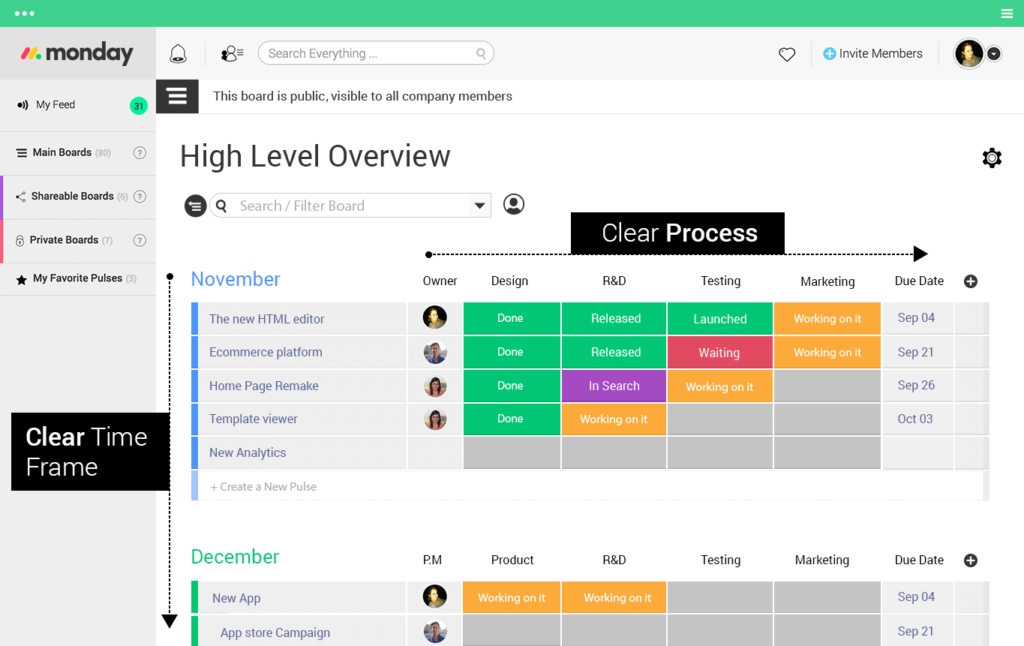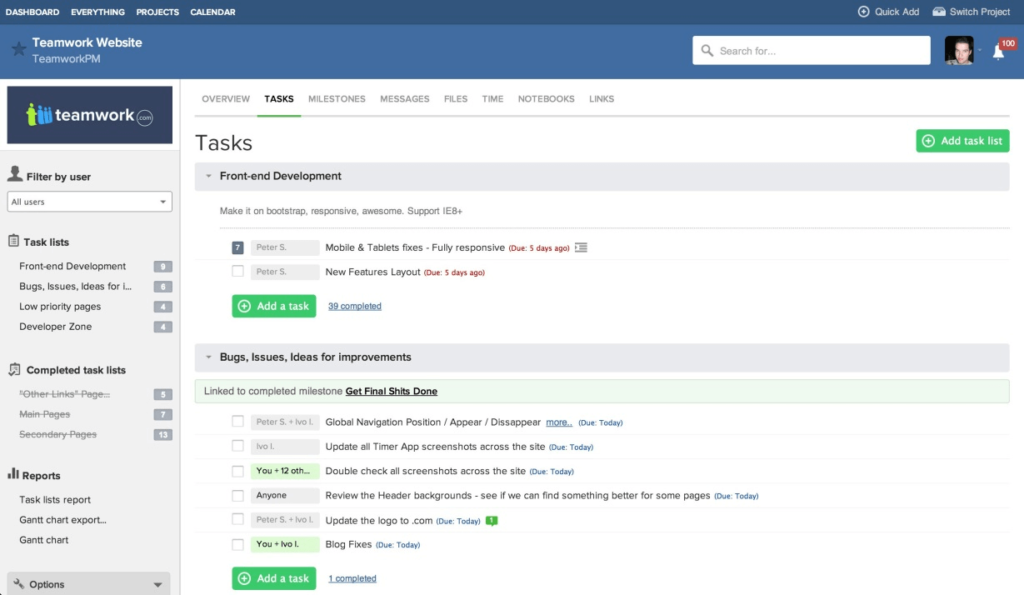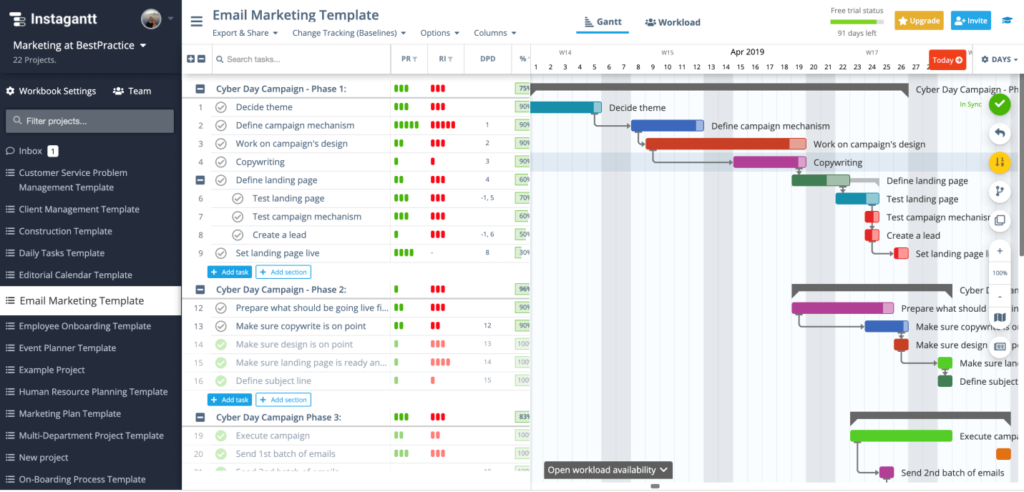
The Project Management software and tools allow project managers and their teams to meet requirements of client and manage budget, time and scope constraints. Though, with numerous options available, selecting the appropriate and right project management appears confusing. Both small and medium-sized businesses are now utilizing online project management tools and software which uses cloud-based technology and is offered as software-as-a-service (SaaS) by application service providers.
With market changes and evolving trends in project management, the tools are expanding their functions and introducing crossing boundaries with different features combination that has complicates the user’s selection process. Are you looking for the top project management tools and software? What is being applied to project management can also be applied to project management tools as well, The efficient ones allows to increase managerial efficiency, minimize confusion, shrink time of completion and so on. Below discussed are the excellent and most commonly used project management tools for students, by companies of all sizes and as per the needs.
Table of Contents
1. Wrike
For project management, it is an award-winning web-based application. Some of its features are;
The Three-Pane View: It holds an intuitive three-pane interface which is geared towards productivity and accessibility. It comprises of;
- The Left pane – encompasses the project hierarchy in order to adjust and edit subtasks.
- The Middle pane – encompasses all project current task lists.
- The Right pane – encompasses tasks detailed information
This interface allows managing almost everything from one workspace, monitoring dependencies of task, project progress reports and team communication easily.
Analytics: It has powerful analytics that provide detailed insights to project managers about their team and the project. The two popular analytics reports are:
- Global report; which analyzes task data over eight different categories. Also, it serves a useful purpose for calculating resource allocation in future and expense tracking.
- Performance chart; it gives a graphical representation of the project’s progress eventually.
Wrike is a visual project management at its best!
Forms and Requests: It eradicates the requirement for countless text notifications and email threads. With their requests and form feature, it becomes easy to communicate information and assign tasks easily.
There is everything on the form that one may need to know. No need for any other follow-ups!
Pros
- It holds an enterprise-level project management capabilities
- Has tons of in-built features, for instance; file sharing and time tracking
- Provide detailed insights in order to calculate deliverables.
Cons
- Lack functionality as mobile apps.
- Particularly for beginners, it isn’t user friendly.
Features that are missing
- It doesn’t add multiple assignees.
- It doesn’t assign comments to team members.
- There are no advanced features such as Mind Maps and Docs
2. Asana
Asana enables to keep track of everything which almost everyone has and is working on. The program provides the ability to form the required list of task and then move it as needed. Along with it, gives a visual project timeline which can be utilized to see everything that has to be done. Allows to set the progress, due dates of notes and ensures that rescheduling and scheduling is easy yet simple.
This application becomes better to use as it works with other several favorites such as; can be linked with Slack, Google Calendar, Outplanr, and Dropbox. These links makes it easy to integrate, also make sure that there isn’t any need to put in information all at once. There is choice of variants to choose, which works the best from free to enterprises.
The features are:
- Document Management
- Time & Expense Tracking
- Project Management
- CRM
- Resource Management
- Portfolio Management
- Collaboration Tools
- Integration with Instagantt
Asana and Wrike seem similar to many, but it differs in a way. The comparison between Asana and Wrike is; the former one allows planning and managing projects in the layout and structure that works efficient as per teams need whereas Wrike offers predefined strict structure to manage the projects.
3. Zoho
From Zoho, the Zoho project is one of the many offerings from it. This indicates a solid mix of all sorts of in the discussed list. The milestones, Gantt charts, time sheets, bug tracking, finance, document management, forums, integration with popular apps, and more — It consist of bits of everything and plays the parts excellently. However, the base plan is normally free for around10 users, and later there is a fixed cost for its use. Using the Zoho business suite of apps along with it makes more sense.
4. Trellos
It is a simple Kanban project management tool which includes features;
Simple Task Management: For each task, there is a “Board” which can be accessed for dashboard by project manager and can make any changes when required. It allows to add custom fields, tags and priorities.
Drag and Drop Functionality allows editing and rescheduling the task and projects.
Power-Ups: It is Trello’s take on features where every task can be given a power-up depending what’s required. It contains features like Google Drive integrations, calendar views, and file sharing. The popular in power-up is their “Butler” feature which allows automating a preset group of tasks!
Pros
- It is a user-friendly interface.
- Easy scheduling and task management
- There are useful power-ups for supplementary functionality
Cons
- There are no views other than Kanban
- Absence of reporting features
- Not able to manage complicated projects
- For functionality, relies on external integrations
- There are no advanced features like native Docs, Mind Maps and Gantt charts
Missing Features
- Absence of box view; only there is Kanban board view
- It doesn’t add multiple project assignees
- Doesn’t give comments to team members
- On the free plan, can’t export projects
5. Workzone
It has been used since 2000 tool and is still used for the features it holds.
Simple Project Management: It is very direct in its approach to project management. The projects are easily accessible the dashboard where the status can also be checked. There are subtasks, assignees and due dates involved. Near the deadlines, it gives notifications. This tool is all about functionality.
Smooth Collaboration: It allows the team members collaborate easily and ensures that the conversations is situated where relevant and neatly ordered.
Reporting Capabilities: This tool provides you detailed reports over various topics. There are;
- Individual performances reports
- Projects progress statuses
- Time management reports
Reports can be viewed as a pie chart, bar chart or as a table.
Pros
- It holds powerful to-do lists.
- Have good reporting capabilities.
Cons
- There is a need of work in Mobile applications
- It lack features like multiple views and assigned comments
- Dated interface
Missing Features
- Absence of free version
- No availability of box view
- Doesn’t allow assigning comments to team members.
- Doesn’t allow adding threaded comments to workspaces.
6. Click up
For managing substantial tasks efficiently, small task, full projects and notes, Click up is the best tool. It’s particularly designed to allow customization in everything, making the system works for you. Also, it enables to do automatic scheduling with estimated times, so one can customized what can be visible to other on the system.
Setting goals and changing up the view is easy, also checking on the project status and more. The system is paid depending on the people on team. The features are;
- Task tray
- Assigned comments
- Notepad
- Dark mode
- Multiple views
- Integrations
7. Monday
This tool provides ample features, involving following LinkedIn and Twitter threads, even also commenting on various different tasks. The access to view the project can be customized. And if using other systems, those can be integrated into the account, including Dropbox, Google Drive and Zapier.
The best part of this tool is the open-source framework that enables to create any integrations or the features needed. One can have an access to detailed reports; add on any people, including freelancers or third-party agents. Depending on the team size, one can choose for different pricing structures. The features are;
- Collaboration tool (various employees)
- Progress is visible through visual display
- Easy communication
- Notifications email
- Execution Board
- Integrations: Google Drive, Dropbox, Pipedrive
8. Teamwork
The tools enables creating workflows, a way that’s simple get handle on and understand. Allows creating different milestones, projects, milestones, tasks and let a use of it on any device. This system works Android, iOS, Web and Google Chrome. IT is accessible by users and team members doesn’t matter the devise type used. The snapshot view let you check on what the team or user is doing.
The manager can assign low, medium and high priority to tasks, and check on how the team is doing, also set up the start and due dates for everything. To keep an eye on everything, it also enables to the use of Gantt style timeliness. All this can be tried free for 30 days and then paid as per the number of team members. The features are:
- Templates
- Workload
- Board View
- Collaboration
- Time Tracking
- Milestones
9. ProofHub
ProofHub is user-friendly and has got a minimal learning curve. It allows organizing the created projects, and the teams responsible for it. Everything can be customized from color scheme to the names, and logos that you use. Even if any team is comfortable with other language, there are even six different language options which you can make it work for them. Setting up each of the team members let you assign roles and provide limited level of access that is needed by each team member. The mobile option works on any devices. The features are;
- Project road mapping
- Collaboration
- Gantt charts
- File sharing
- Chat
- Idea management
- Multi-language
10. Instagantt
It’s particularly designed to work with Asana; a project management tool. Also allows to link schedules from other sources. It indicates that once the information is put in, it would be visible across different platforms. Here one can set up the task and timeliness, also manage and monitor teams’ workload. Even if not using Asana, one can still get a lot out of this system, encompassing assigning and monitoring tasks, putting due dates, and assessing progress. These elements comes in different price points that help you work with the team and keep apprised of things that needs to be done. The features are;
- Gantt and workload view
- Public snapshot sharing options
- Task and subtasks
- Timelines
- Milestones and dependencies
- Multiple projects and workspaces
- Critical path
- Team collaboration options: task assignment and notification
- Risk and priority
- Baselines
- Estimated and actual cost
- Custom view and custom fields
- Drag & drop
- Custom color options for progress bars
- Diverse exporting options: PDF, image and Excel
















